As lingering snow banks melt we look forward to the arrival of our favorite spring guests. They arrive in late April, but we put out the welcoming mat a month ahead.
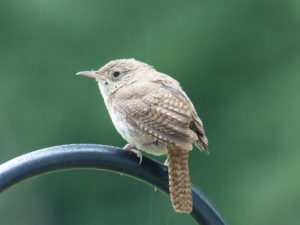
We welcome the wrens each spring
For many years a pair of house wrens have nested right outside our dining room window. We laugh at their bubbly energy and enjoy watching them bring caterpillar after caterpillar into their home to feed growing babies. In some years we get to watch as the youngsters peer outside their nest box before taking their first awkward and short flight.
How Many Species live in the United States?
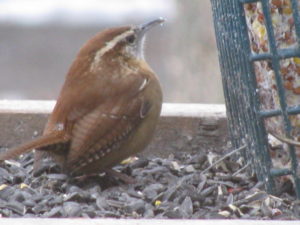
Sometimes the Carolina wrens stay around in winter.
House wrens are only one of six wren species that live in the United States. We’re fortunate to have both house and Carolina wrens in our
yard. Carolinas don’t migrate, so we sometimes see one feeding on suet in winter. House wrens are, perhaps, wiser and leave Iowa each October to winter down along the Gulf Coast.
It’s almost magical when the house wrens return each late April. Suddenly the air is filled with their delightful song. We usually hear them before we spot their nervous energy as they seek a nesting location. The nest boxes we set up in March are their welcome mat.
Making a Birdhouse
Few birds are as easy to lure into a nest box as house wrens. In winter we make new ones out of scrap lumber. Wrens aren’t fussy. Many elaborate nest boxes can be purchased but all it takes to make one is a four-foot section of 1X6 inch pine lumber, a few nails, and simple tools. We like the plans posted on Birdwatching Bliss.
We’re crude carpenters but the birds don’t seem to mind if the joints aren’t perfect.
Many wren house plans call for a circular opening of 1 1/8th inch but we’ve had great success with a one-inch hole. Larger holes welcome messy house sparrows. We also never place a perch in front of the entry hole. Wrens are acrobatic flyers and have no trouble entering a hole without a perch nearby.
Entertainment
Few birds are as entertaining as bubbly house wrens, but there’s another reason we love having them around. They’re voracious predators of insects that love feasting on our garden crops, so our wren tenants help boost our vegetable crop.
Wrens start nesting almost as soon as they arrive. Their nest is carefully made of small sticks that nestle a few reddish spotted eggs that hatch in about two weeks. Babies grow like fury and leave the nest by the end of June. We then clean the nest out of the box, and often the eager parents produce a second brood in the late summer.
No bird is as likely to fascinate a child as a pair of bubbly wrens nesting in full view just outside the window.
- Checking the nest box.
- Eggs are spotted reddish
- Looking out at the world.

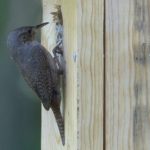
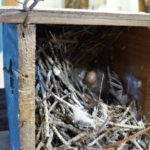
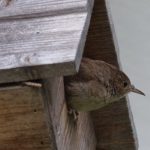

I love that there are people in the world that love birds! (I am just not one of them – but, I will not be surprised if when my daughter grows up she has one). Our discussion the other day went something like this:
“Mom, can we get a bird?”
“Nope. Sorry.”
“I want a parrot.”
“Nope, we’re not getting a parrot. You have to clean out their cages.”
But, I forgot that she CAN have birds if we just don’t mind them not being pets. I love the idea of having a nesting box for them – and living close to the river means bountiful insects for them to enjoy.
I wonder if my STEAM loving children and my husband and I can put together a nesting house sometime…hmmmm – something to think about.